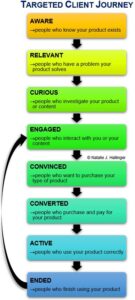Snag Your First Paying Client
as an Independent Consultant – Part 3
Another approach to the first steps in the Client Journey – spread awareness of your product among past collaborators while seeking testimonials and contract work.
First Clients Strategy #2
Get Work or Testimonials from Past Employers and Coworkers
Potential clients want to know that you are competent and trustworthy. The most credible source of that information is people who have worked with you in the past (coworkers, supervisors, supervisees, etc.). You know your intentions, but others can describe how well those intentions are delivered. Gather testimonials from paid and unpaid work that you can share with potential clients.
Past collaborators are also likely to want to work with you again. They already know some of your expertise and your approach, so the remaining questions are whether they currently have a problem that you can solve and if they are able to pay for your work.

1. Identify your available support network
Make an actual list so you can track your progress with contacting each person, their response, and your follow-up. Some people can be contacted with a mass message or presentation, such as members of a club, association, or religious group. Others are best reached directly, such as friends, mentors, or past clients.
Tracking also helps you see how vast your network is, which will boost your confidence in the outcome.
-
-
- Family (immediate and extended)
- Friends (close and distant)
- Neighbors
- Past classmates or instructors
- Past coworkers or supervisors
- Past clients or employers
- Mentors or mentees
- Social media connections or followers (personal and professional)
- Club or association members
- Religious or cultural group members
-
2. Create a testimonial gathering strategy
Keep it short and to the point. Use an outline or bulleted list.
Identify the testimonial components you want highlighted. What information is most important to potential clients considering a product like yours? Which areas are a strength for you? Collaboration, problem-solving, working with few resources, managing bureaucratic processes, adjusting to barriers, building buy-in, presenting to executives, speed or efficiency, delivering on promises, consistent communication, conflict resolution, etc.
Determine the type of connections able to comment on the testimonial components of interest.
Decide which contact technique(s) you will use. Phone call, email, direct message, or in-person meeting?
Draft an email template, survey, or checklist. What kind of ask will motivate people to write and share their testimonial?
3. Identify past coworkers, collaborators, and employers to ask
This will likely be a subset of your full network list described in the referral step above. Be sure to focus on including people who obviously enjoyed working with you or who explicitly praised your contributions (verbally or in writing).
Note that targets for testimonials might be willing to provide referrals, too, but it is more productive to focus on just one ask at a time.
4. Tailor the ask to each individual
Asking for a testimonial is a private conversation, so focus on individual approaches. Remind your audience of the project you both collaborated on. Specify the testimonial components you prefer that they mention.
Be prepared for a discussion before they agree since testimonials take some effort to compose. Provide a generous timeline for completion.
-
-
- Part 1 – Targeted Client Journey
- Part 2 – First Clients Strategy #1: Get Client Referrals from Your Network
- Part 3 – First Clients Strategy #2: Get Work or Testimonials from Past Employers and Coworkers
- Part 4 – First Clients Strategy #3: Get Leads from Fresh Outreach
- Part 5 – First Clients Strategy #4: Engage Leads with Meaningful Content
-

Comments are closed, but trackbacks and pingbacks are open.